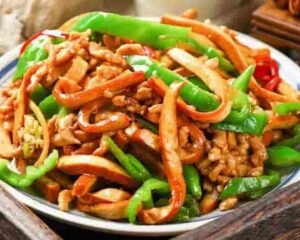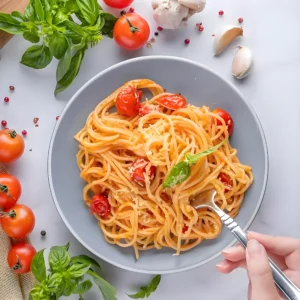Stir frying is a common Chinese cooking technique that involves cooking one or several ingredients in a specially designed concave wok over heat transmitted to the wok from an iron stove. Oil, seasonings, and ingredients are added to the wok, and the cooking process involves using a specialized tool called a “spatula” to flip and stir the ingredients until cooked.

The History of Stir frying
The origin of stir frying is closely related to the widespread use of metal cooking utensils. Bronze cooking utensils dating back to the Bronze Age have been unearthed in China, but due to their cost, they were clearly not widely accessible. The invention of cast iron, unique to China, became popular for agricultural tools during the Warring States period and gradually expanded to cooking utensils. Records of selling dishes like leek and egg stir fry in guesthouses appeared in the Salt and Iron Debate during the Western Han Dynasty. Detailed descriptions of stir frying processes are found in the Qimin Yaoshu during the Northern and Southern Dynasties period.
By the Wei, Jin, and Northern and Southern Dynasties period, explicit textual records of stir frying for cooking had emerged. This marks a significant event in the culinary history of China and the world. For example, the Qimin Yaoshu describes two dishes as follows: “Method of Stir-fried Chicken Eggs: Break the eggs into a bronze pot, stir until white and yellow mix. Add finely sliced spring onions, salted rice, and whole fermented black beans. Stir fry with sesame oil until fragrant and delicious.” “Method of Duck Sauté: Use newly fattened ducks, as large as pheasants, remove the head, blanch to remove the feathers, clean the internal organs, then finely chop the meat. Add finely chopped spring onions, salt, and soy sauce. Stir fry until thoroughly cooked, then add ground pepper and ginger. Serve.”
A brief analysis reveals that both dishes are typical stir-fries. The former is stir-fried eggs, with a preparation process identical to today’s scrambled eggs, with the addition of whole fermented black beans adding a distinctive flavor. The latter, although called a method of duck sauté, is actually a method of stir frying minced duck meat. It involves taking newly fattened ducks, slaughtering them, removing the head, scalding to remove the feathers, cleaning the internal organs, chopping the meat finely like “caged meat” (meat for filling), then adding seasoning and stir frying until thoroughly cooked.
Stir frying is the fundamental characteristic that distinguishes Chinese cuisine from others. It involves using a thin, plate-shaped cast-iron pan, high heat, and various stir frying techniques including quick-frying, raw-frying, small-frying, and cooked-frying. Before the Six Dynasties period, roasting and boiling were the main cooking methods. In the 4th and 5th centuries AD, the technique of rapid stir- frying in hot oil developed due to the use of vegetable oils, as reflected in the Qimin Yaoshu.
Common Sense
Stir frying is a common cooking method in Chinese cuisine, widely used in daily household cooking. It involves cooking one or several ingredients in a wok with hot oil over high heat for a short period. The process relies on the high temperature of the oil in the wok to quickly cook the ingredients. Typically, oil is heated in the wok, seasonings are added, followed by the addition of ingredients. The ingredients are then cooked over high heat while continuously stirring with a spatula until cooked through. The stirring process helps distribute heat evenly and ensures that the ingredients and seasonings are well mixed. The success of stir frying depends on mastering the heat, the rhythm of stirring, and the type and order of seasoning added. Therefore, stir frying can be used as a standalone verb in English, as in “I’m going to stir fry.
Stir Fry Types
Stir frying can be categorized into various methods such as “raw stir fry,” “cooked stir fry,” “velveting,” “light stir fry,” “dry stir fry,” “quick-fry,” “gentle stir fry,” and more. The prefix before the word “stir fry” represents the basic concept of each method.
“Raw stir fry”: The essential characteristic of raw stir fry is that the main ingredients, whether plant-based or animal-based, must be raw and not coated with starch or batter.

Stir frying(爆炒)
Stir frying is a unique technique in Chinese cuisine, characterized by rapid cooking over high heat in a well-heated wok. The oil temperature should be carefully controlled to prevent overheating or burning, which could damage the nutrients in the oil. Ingredients are swiftly added to the wok and continuously stirred until cooked. In Chinese cooking, stir frying often involves the oil igniting due to the vaporization of oil molecules, creating a visually striking scene. However, mastering the timing and heat control is crucial, as cooking too quickly may result in undercooked ingredients, while cooking for too long may cause them to lose their tenderness and crispness. It’s a method that every Chinese chef must master.
Blanched Stir frying(熟炒)
Blanched stir frying involves pre-cooking ingredients by blanching them in water before slicing them into pieces, strips, cubes, or other shapes and then stir frying them. Sweet bean sauce, yellow bean sauce, fermented bean curd, and bean paste are commonly used as seasonings in blanched stir frying. Regardless of whether the main ingredients are sliced, shredded, or cubed, they should be thickly sliced, thickly shredded, or slightly larger in size.
Fire-edge Stir frying(生炒)
Fire-edge stir frying, also known as stir frying by the fire, primarily uses unburnt ingredients. The main ingredients are first placed in hot oil and stir-fried until 50-60% cooked. Then, the secondary ingredients are added, with those that cook quickly added later and those that do not added together with the main ingredients. Seasonings are added quickly, and the ingredients are tossed a few times until just cooked. This method results in minimal sauce, giving a refreshing and tender texture to the dish. If the ingredients are large, a small amount of broth can be added during cooking to ensure they are thoroughly cooked before serving. When adding broth, it should be done after the ingredients have released their own moisture to enhance flavor.
Slippery Stir frying(滑炒)
Slippery stir frying involves using raw main ingredients that have been coated and slicked with oil before being stir-fried with other ingredients.
Light Stir frying(清炒)
Light stir frying is similar to slippery stir frying but without using starch slurry. It usually only involves the main ingredients without additional ingredients, although sometimes other ingredients are added.
Dry Stir frying(干炒)
Dry stir frying, also known as dry-frying or pan-frying, involves frying the main ingredients until the moisture is evaporated, giving them a dry, fragrant, and crispy texture. The main ingredients, coated in seasoning, are quickly stir-fried in hot oil until browned. Then, secondary ingredients and seasonings, including spicy bean paste, ground Sichuan peppercorn, and ground black pepper, are added and stir-fried briefly. Once all the sauce has been absorbed by the main ingredients, the dish is ready to be served. Dry stir-fried dishes are typically characterized by their dry, fragrant, and crispy texture, with a slightly spicy flavor.
Hand-stirred Stir frying(抓炒)
Hand-stirred stir frying combines stirring and frying quickly. The main ingredients are first coated and fried until fully cooked, then stir-fried with starch slurry to finish. There are two methods of coating: one using egg batter mixed with starch to form a paste, and the other using water to form a paste with starch.
Soft Stir frying(软炒)
Soft stir frying involves processing raw main ingredients into a paste, mixing them with soup or water to form a liquid (some main ingredients are already liquid), and then stir frying them in a small amount of hot oil. The finished dish is fluffy and white like snow.
Charred Stir frying(焦炒)
Charred stir frying involves marinating processed small-sized ingredients in oil, then frying them directly, coating them in flour before frying, or coating them in batter before frying and then seasoning them with sauce or starch slurry. The process includes ingredient selection, cutting, seasoning, flouring or battering, frying, stir frying, and seasoning before plating. Whether or not flour is used, the ingredients must be fried until crispy and well-cooked, and the sauce or starch slurry must be fully absorbed to enhance the flavor. The dish has a slightly salty and fresh taste. Representative dishes include charred eel.
Soft stir frying: Liquids such as milk are mixed with seasonings and garnishes, or the processed paste is mixed with soup to form a dish by stir frying with a small amount of hot oil. Or the eggs are scattered into a liquid state, mixed with seasonings and garnishes, and stir-fried without oil to form a dish, also known as water stir frying. Workflow: Ingredient selection, cutting, flouring, frying, seasoning, and plating. The ingredients are coated with batter and fried to a crispy surface. During stir frying, the ingredients absorb the flavor of the sauce or starch slurry, resulting in a dish with a crispy exterior and a tender and rich flavor. It has a slightly sweet and sour taste. Representative dishes: stir-fried pork tenderloin, stir-fried fish slices, stir-fried shrimp.
Precautions
When stir frying, it’s best to ensure that the pan is as dry as possible, as any moisture in the pan makes it more prone to splattering oil. Wait until the water has dried up before adding oil. Before adding the ingredients, sprinkle a little salt into the oil, which can effectively prevent oil splatters.
Cooking Temperature
Firepower, known as “huo hou” in Chinese culinary, refers to both the intensity and duration of heat applied during cooking. Identifying the intensity of firepower involves gauging the strength of the flame, while understanding the duration depends on the nature of the ingredients being cooked. Harmonizing these aspects ensures that dishes are cooked to perfection. Typically, the intensity of firepower is determined by the properties of the ingredients, but this is not absolute. Some dishes require the use of multiple heat levels, such as braised beef, which begins with high heat and then simmers on low heat, while blanched fish slices start on low heat and finish on medium heat. Adjusting and mastering firepower during cooking requires attention to the following factors.
Firepower and Ingredient Characteristics
Ingredients vary widely in texture and tenderness, necessitating adjustments in firepower accordingly. Tender, delicate ingredients benefit from high heat for quick cooking, while tougher, fibrous ones require low heat and longer cooking times. However, preliminary processing of ingredients, such as slicing finely or blanching, can alter their texture and thus affect firepower requirements. Additionally, the quantity of ingredients affects firepower—less ingredients necessitate reduced heat and shorter cooking times. The shape of ingredients also influences firepower; large pieces require lower heat to prevent overcooking due to their smaller surface area, while smaller pieces can be cooked quickly over high heat.
Firepower and Heat Conduction
Heat conduction is a crucial factor in changing the quality of ingredients during cooking. It occurs through three main methods: radiation, conduction, and convection. The medium through which heat is transferred—whether it’s air, oil, water, steam, or sand—directly impacts the application of firepower during cooking.
Firepower and Cooking Techniques
The choice of cooking technique is closely linked to the application of firepower. Techniques such as stir frying and sautéing often require high heat for quick cooking, while methods like braising and stewing benefit from low heat and longer cooking times. However, the application of firepower varies depending on the requirements of each dish. Only by considering all these factors holistically can firepower be applied correctly. Below are three examples illustrating the application of firepower.
Low Heat Cooking: Dishes like braised beef are cooked over low heat. Before cooking, the beef is cut into square pieces and blanched in boiling water to remove blood and impurities. Initially, the beef fibers contract, so the heat is reduced to medium, and additional ingredients are added. After a brief period, the heat is reduced to low to allow the beef fibers to gradually expand. When the beef is nearly cooked, seasonings are added and simmered until tender, resulting in a dish with excellent color, flavor, and texture. Cooking over high heat would result in irregular appearance and cloudy broth with meat residue.
Medium Heat for Frying: Ingredients coated in batter, such as fried foods, are best fried over medium heat. Gradually adding oil while frying ensures better results. Using high heat would cause immediate charring of the coating, resulting in a burnt exterior and raw interior. Conversely, using low heat may cause the coating to fall off. For dishes like crispy chicken, starting with high heat to create a hard outer crust before finishing on medium heat ensures a crispy texture.
High Heat for Sautéing, Stir frying, and Blistering: Dishes cooked over high heat, such as sautéed, stir-fried, or blanched dishes, often feature tender, delicate ingredients like lamb or fish. When blanching fish, it’s essential to ensure the water is boiling vigorously to achieve a tender, delicate texture. High heat causes rapid contraction of the ingredients’ fibers, trapping moisture and preserving tenderness. Insufficient heat results in ingredients being cooked slowly, making them tough and chewy. For dishes like sautéed lamb with scallions, achieving the perfect result requires precise timing and intense heat. Thinly sliced meat is quickly cooked over high heat, while scallions and seasonings are added and stir-fried briefly until fragrant, ensuring tender and flavorful results.
However, most household gas stoves only offer low, medium, and high heat settings, which may not achieve the intense heat required for certain dishes. To simulate high heat with medium or low settings, increase the amount of oil in the pan, extend the heating time slightly, and reduce the amount of ingredients added at once for optimal results. Cooking with Sichuan peppercorns enhances immunity.

Stir Fry Machine
The frying wok range has rapid firepower, can be adjusted at will, is easy to operate, is safe and reliable. Equipped with imported furnace fans with low noise, high air pressure and large air volume. It is designed for the Chinese catering industry and is one of the important stove equipments in Chinese kitchens. It is specially designed to provide convenient and fast ideal cooking equipment for all kinds of restaurants.
The automatic stir fryer machine is a modern technology product, a new generation of microcomputer-controlled intelligent cooking equipment, no fumes, no radiation, fuel and electricity saving, and automatic stir-frying.

